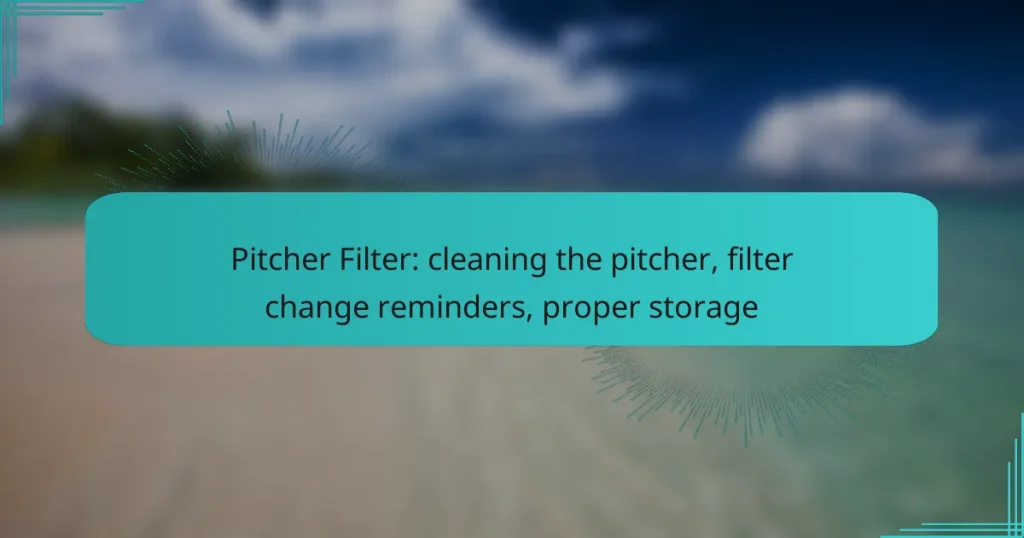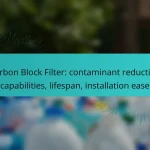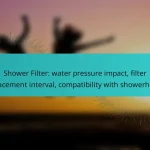Maintaining your pitcher filter is essential for ensuring clean and great-tasting water. Regular cleaning and timely filter changes not only enhance water quality but also prolong the lifespan of your pitcher. Proper storage of your pitcher when not in use can further contribute to its effectiveness and longevity.

How to clean a pitcher filter in the UK?
Cleaning a pitcher filter in the UK involves simple steps to ensure it functions effectively and lasts longer. Regular maintenance, including cleaning and filter changes, helps maintain water quality and taste.
Use warm soapy water
Start by disassembling the pitcher and removing the filter. Use warm soapy water to clean the pitcher and its components, as this helps to remove any residue or build-up. A mild dish soap works well for this purpose.
Make sure to use a soft sponge or cloth to avoid scratching the surfaces. Pay particular attention to the areas where the filter sits, as these can accumulate grime over time.
Rinse thoroughly
After cleaning with soapy water, rinse all parts under running water. This step is crucial to remove any soap residue, which can affect the taste of your water. Ensure that both the pitcher and the filter housing are thoroughly rinsed.
It’s advisable to let the components sit for a few minutes after rinsing to ensure all soap is washed away before reassembling.
Use vinegar for tough stains
If you encounter stubborn stains or mineral deposits, consider using a solution of equal parts vinegar and water. Soak the affected areas for about 15-30 minutes to help break down the stains.
After soaking, scrub gently with a soft brush or sponge, then rinse thoroughly. Vinegar is a natural cleaner that can effectively tackle tough stains without harsh chemicals.
Dry completely before reassembly
Before putting your pitcher back together, ensure all parts are completely dry. This prevents any moisture from promoting mold or bacteria growth. Use a clean towel or let the parts air dry on a drying rack.
Once dry, reassemble the pitcher and insert a new filter if needed. Regular cleaning and proper storage will extend the life of your pitcher filter and maintain water quality.

When should you change the pitcher filter?
You should change the pitcher filter regularly to ensure optimal water quality. Typically, this involves changing the filter after a certain volume of water has been filtered or after a specific time period, depending on usage.
Every 40 gallons of water
A common guideline is to replace the pitcher filter after filtering approximately 40 gallons of water. This volume can vary based on the specific model and water quality in your area. Keeping track of how much water you use can help maintain effective filtration.
Many pitchers come with a built-in indicator that tracks the number of gallons filtered, making it easier to know when to replace the filter. If your pitcher does not have this feature, consider marking your calendar or using a reminder app.
Every two months for regular use
If you use your pitcher regularly, it’s advisable to change the filter every two months, even if you haven’t reached the 40-gallon mark. This ensures that the filter remains effective in removing contaminants and improving taste.
For households with higher water consumption, such as families or those who drink a lot of water, more frequent changes may be necessary. Monitoring your usage will help you determine the best schedule for your needs.
Check for discoloration or odor
In addition to following the time and volume guidelines, always check the filter for any signs of discoloration or unusual odors. These can indicate that the filter is no longer effective and should be replaced immediately.
If you notice any changes in the taste or smell of the water, it’s a good idea to change the filter regardless of the time or volume used. Regular visual and sensory checks can help ensure that your water remains clean and safe to drink.
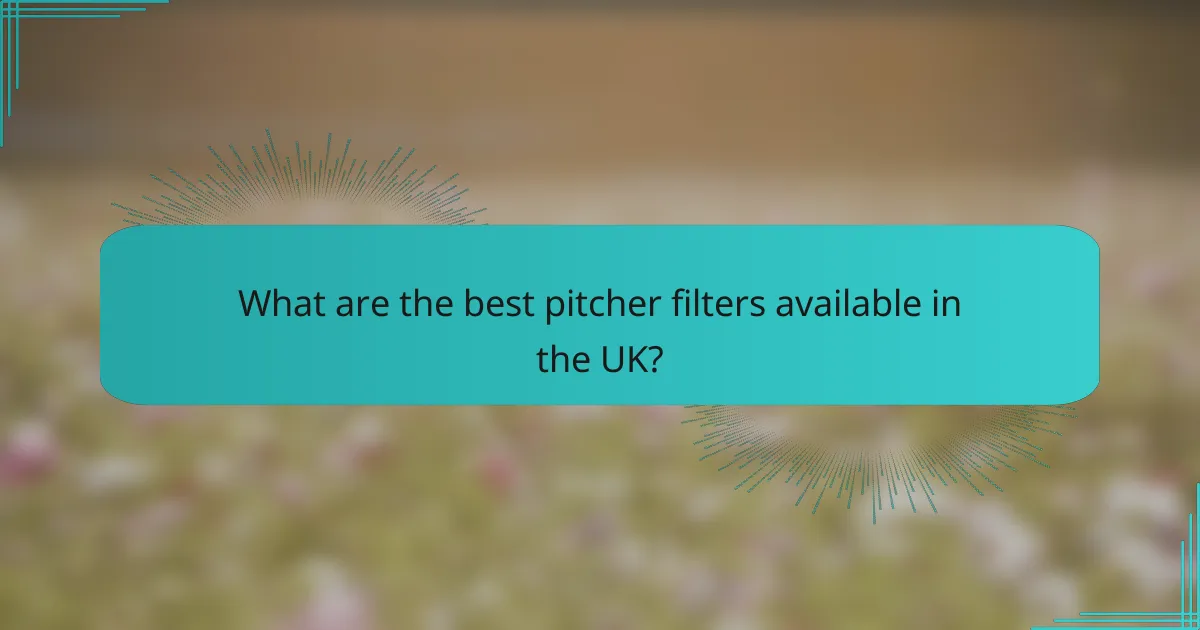
What are the best pitcher filters available in the UK?
The best pitcher filters in the UK include options that effectively reduce contaminants while improving taste. Popular choices like Brita Maxtra+, ZeroWater, and PureH2O offer varying filtration technologies and capacities to suit different needs.
Brita Maxtra+
The Brita Maxtra+ filter is well-known for its ability to reduce chlorine, limescale, and heavy metals, enhancing the taste of tap water. It uses a combination of activated carbon and ion exchange resins to achieve this, making it a reliable choice for everyday use.
When using Brita Maxtra+, it’s recommended to replace the filter every four weeks to maintain optimal performance. The filters are widely available in supermarkets and online, typically costing around £6 for a pack of three.
ZeroWater Filter
ZeroWater filters utilize a five-stage filtration system that removes virtually all dissolved solids from water, making it one of the most effective options on the market. This includes contaminants like lead and mercury, which can be a concern in some areas.
Due to its thorough filtration, ZeroWater filters need to be replaced more frequently, usually every two to three months, depending on water quality. A pack of filters generally costs about £20, reflecting its premium filtration capabilities.
PureH2O Filter
The PureH2O filter is designed to reduce chlorine and other impurities, providing clean and great-tasting water. It is a more budget-friendly option compared to others, making it accessible for many households.
For best results, replace the PureH2O filter every month. These filters are often priced around £5 for a pack of two, making them an economical choice for regular water filtration needs.
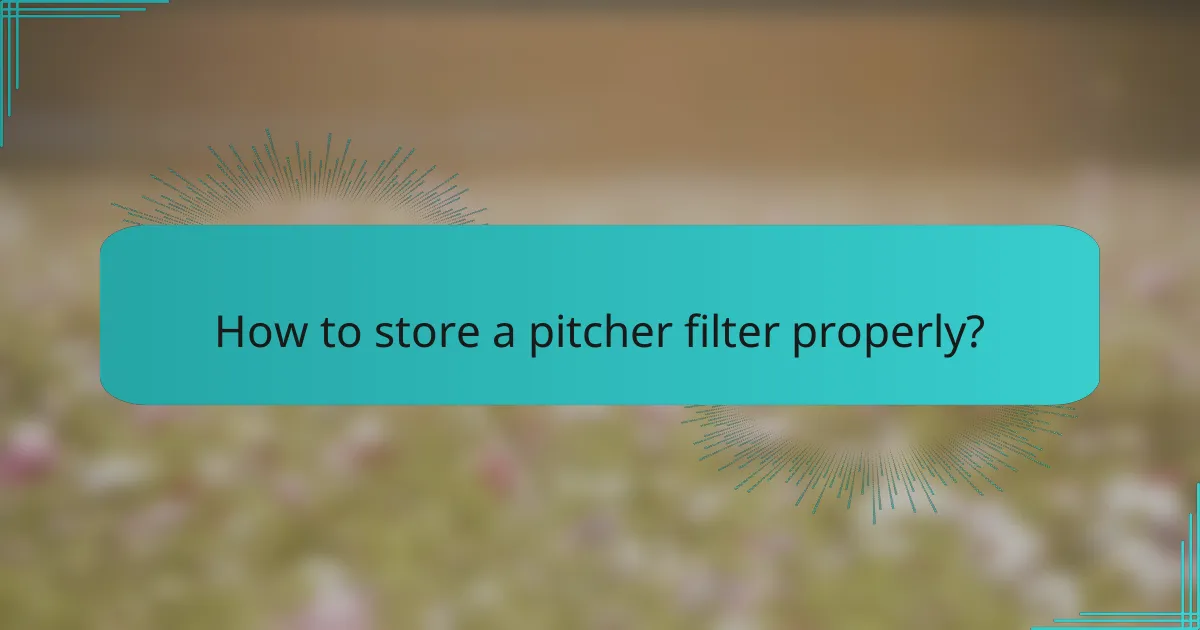
How to store a pitcher filter properly?
Proper storage of a pitcher filter is essential to maintain its effectiveness and prolong its lifespan. Keeping the filter in suitable conditions helps prevent contamination and ensures optimal water quality.
Keep in a cool, dry place
Storing your pitcher filter in a cool, dry place is crucial for preventing mold and bacteria growth. Ideal storage temperatures are typically between 10°C to 25°C (50°F to 77°F). Avoid areas like kitchens or bathrooms where humidity levels can fluctuate.
Consider placing the filter in a pantry or a cupboard away from heat sources such as stoves or ovens. This will help maintain the filter’s integrity and performance over time.
Avoid direct sunlight exposure
Direct sunlight can degrade the materials of the pitcher filter, reducing its effectiveness. Ultraviolet (UV) rays can break down the filter’s components, leading to a shorter lifespan.
Store the filter in opaque containers or wrap it in a cloth to shield it from light. This simple step can significantly extend the filter’s usability and ensure cleaner water.
Store in the refrigerator for freshness
For added freshness, consider storing your pitcher filter in the refrigerator. This helps maintain a stable temperature and can inhibit the growth of bacteria.
Make sure the filter is sealed in a clean, airtight container to prevent it from absorbing odors from other foods. This practice is particularly beneficial if you live in a warm climate or during hot seasons.

What are the benefits of using a pitcher filter?
Using a pitcher filter provides cleaner, better-tasting water by removing impurities and contaminants. It is a convenient and cost-effective solution for improving water quality at home.
Improves water taste
A pitcher filter enhances the taste of tap water by reducing chlorine and other unpleasant flavors. This makes drinking water more enjoyable, encouraging better hydration habits.
Many users report a noticeable difference in taste after using a pitcher filter, which can lead to increased water consumption. For those sensitive to taste, this improvement can be significant.
Reduces contaminants
Pitcher filters are designed to remove various contaminants, including heavy metals, sediment, and some bacteria. This can lead to safer drinking water, particularly in areas with questionable water quality.
While not all filters are created equal, many meet standards set by organizations like NSF International, ensuring they effectively reduce specific contaminants. Regularly checking filter specifications can help users choose the right product for their needs.
Cost-effective compared to bottled water
Using a pitcher filter is generally much cheaper than purchasing bottled water. The initial investment in a pitcher and filter cartridges can lead to significant savings over time.
For example, a pitcher filter can cost around $20, while bottled water may range from $1 to $3 per bottle. Over a month, the savings can add up to substantial amounts, making pitcher filters a practical choice for households.

What are the signs of a clogged pitcher filter?
Signs of a clogged pitcher filter include noticeably slower water flow and changes in taste or odor. These indicators suggest that the filter is no longer effectively removing contaminants and should be addressed promptly.
Slow water flow
One of the most common signs of a clogged pitcher filter is slow water flow. If you notice that it takes significantly longer for water to filter through, this is a clear indication that the filter is becoming obstructed. The flow rate can drop from a few seconds to several minutes, depending on the level of clogging.
To assess the situation, try pouring water into the pitcher and timing how long it takes to filter completely. If it exceeds a few minutes, it’s time to consider cleaning or replacing the filter. Regular monitoring can help you catch this issue early, preventing further complications.
Changes in taste or odor
Another sign of a clogged pitcher filter is a noticeable change in the taste or odor of the water. If the water begins to taste metallic or has an unusual smell, it may indicate that the filter is no longer effective at removing impurities. This can happen when the filter becomes saturated with contaminants.
To maintain water quality, it’s essential to replace the filter according to the manufacturer’s recommendations, typically every two to three months, or sooner if you notice these changes. Keeping a calendar or setting reminders can help ensure timely filter changes.
Visible sediment or discoloration
Visible sediment or discoloration in the water is another warning sign that your pitcher filter may be clogged. If you see particles floating in the water or if it appears cloudy, the filter may not be functioning properly. This can compromise the safety and taste of your drinking water.
Inspect the filter regularly for any signs of wear or damage. If you notice any discoloration or sediment, it’s best to replace the filter immediately to ensure clean and safe drinking water.
